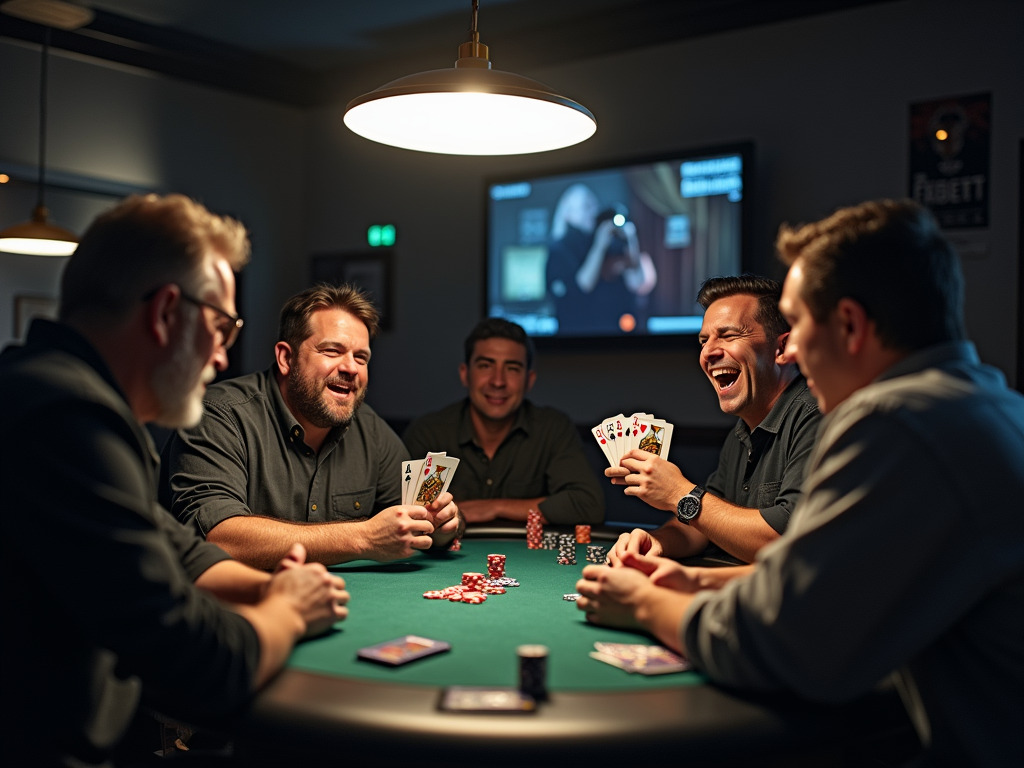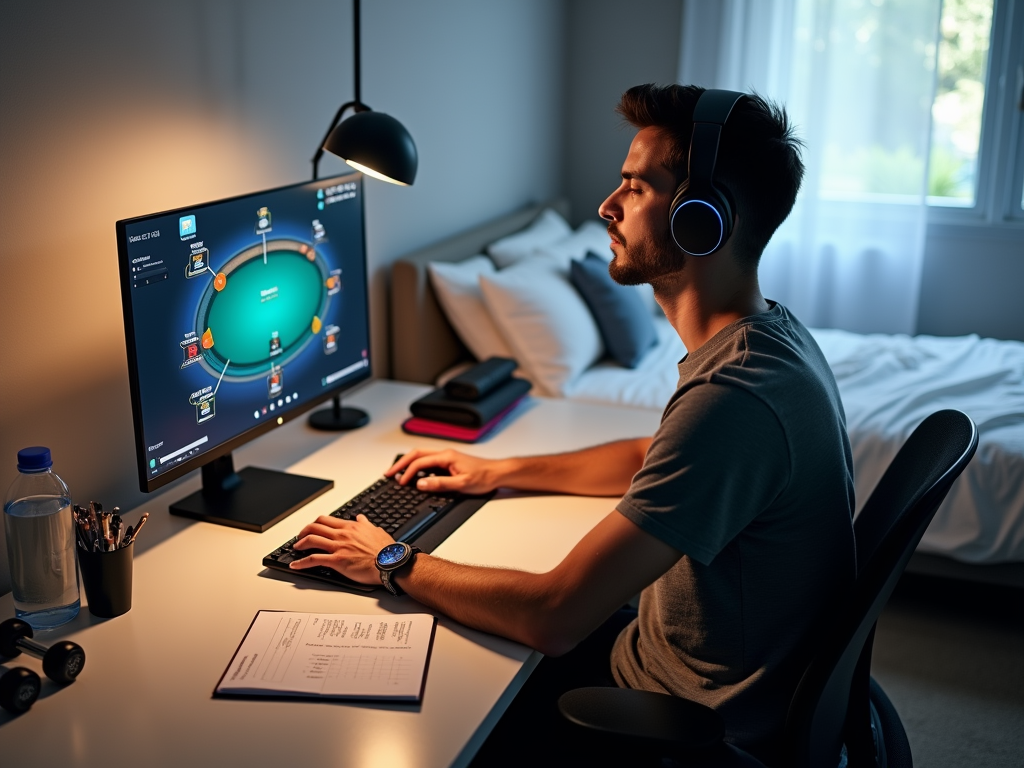The Science and Psychology of Poker Tilt
Poker tilt disrupts rational decision-making through emotional responses, as the brain’s amygdala hijack response can destroy skilled players’ performance. The biological and psychological elements of tilt create a critical impact on poker players, turning calculated strategy into expensive mistakes that multiply losses.
Key Takeaways
- Tilt manifests in five main forms: anger, fear, frustration, entitlement, and overconfidence tilt
- Physical warning signs like muscle tension, racing heartbeat, and shallow breathing indicate approaching tilt
- The brain can only process about 7 pieces of information simultaneously, making mental resource management crucial
- Proper bankroll management (20-100 buy-ins) provides emotional freedom for clear decision-making
- Regular breaks, deep breathing exercises, and positive self-talk help maintain mental control during sessions
I’ve learned that emotional control stems from recognizing early warning signs and implementing proven countermeasures. My experience shows that physical symptoms often precede mental tilt, making body awareness essential. Players who master their emotional responses gain a significant edge at the table.
Biology and Tilt: How Stress Affects Your Brain
The science behind tilt reveals how stress hormones impair decision-making abilities. This knowledge helps create effective prevention strategies. Smart bankroll management builds a psychological buffer against losses, while regular breaks reset mental focus.
Building Your Tilt Management System
Successful poker players develop personal tilt management systems through practice and self-awareness. These strategies protect their bankroll and maintain peak performance during challenging sessions.
What Really Happens When You Tilt: The Science Behind Poker’s Biggest Mental Game Leak
The biological impact of tilt on poker players runs deeper than most realize. I’ve seen countless skilled players fall victim to this emotional spiral that can destroy hours of disciplined play in minutes. Let’s break down the science and psychology behind poker’s most costly mental challenge.
The Biology of Tilt
Your brain has a built-in emergency response system centered in the amygdala – the emotional control center. During tilt, this system kicks into overdrive through what scientists call an “amygdala hijack.” This creates a fight-or-flight response that bypasses your rational thinking processes, making it nearly impossible to stick to optimal strategy.
Mastering poker psychology requires understanding these five core manifestations of tilt:
- Anger Tilt: Aggressive betting and calling with marginal hands
- Fear Tilt: Overly passive play and missing value betting spots
- Frustration Tilt: Chasing losses and playing too many hands
- Entitlement Tilt: Feeling “due” for a win and making loose calls
- Overconfidence Tilt: Overvaluing hands and refusing to fold
Impact on Decision Making
The effects of tilt on your game can be devastating. When emotions take control, your ability to make Game Theory Optimal (GTO) decisions drops significantly. Your normally sharp poker instincts become clouded by emotional interference.
During tilt episodes, I’ve noticed players commonly:
- Raise with weaker hands than usual
- Call down too light against obvious strength
- Bluff in spots where they should give up
- Size their bets incorrectly
- Miss crucial tells from opponents
These deviations from solid strategy create exploitable patterns that observant opponents can use against you. Each emotional decision compounds the problem, leading to bigger losses and more intense tilt – a vicious cycle that’s hard to break without proper understanding and preparation.
The shift from logical to emotional decision-making happens faster than most players realize. Your brain can switch from strategic thinking to reactive emotional responses in fractions of a second. This quick transition explains why even experienced players can find themselves making obviously poor decisions before they’ve had time to consciously intervene.
Recognizing these biological and psychological processes is the first step in developing effective countermeasures. By understanding what’s happening in your brain during tilt, you can start building mental frameworks to catch these episodes early and maintain your strategic edge at the table.

Why Even Good Players Fall Into the Tilt Trap
Let’s face it – tilt doesn’t discriminate based on skill level. I’ve seen countless skilled players succumb to this emotional state that can derail even the most strategic poker player’s decision-making abilities.
Common Tilt Triggers and Their Impact
The path to tilt often starts with specific triggers that chip away at a player’s emotional control. Here are the key situations that frequently push players over the edge:
- Bad beats – especially when playing correctly but losing to statistically unlikely outcomes
- Coolers – those unavoidable situations where strong hands clash
- Extended losing streaks that test patience and bankroll management
- Frustrating opponent behavior, like slow-rolling or excessive celebration
- Statistical variance that defies short-term expectations
The psychological impact hits harder in specific game formats. Cash games can create pressure due to immediate money implications, while tournaments amplify stress through elimination pressure. Online play adds another layer with its rapid pace and lack of physical tells to read.
Life stress acts as a silent tilt multiplier. Financial pressure, relationship issues, or work problems can lower your mental defenses, making you more susceptible to emotional reactions at the table.
Take the classic scenario of losing with pocket Aces to pocket Kings when a King hits on the river – a mere 2% probability. Even though good players understand this variance intellectually, the emotional impact can still trigger tilt. This disconnect between logical understanding and emotional reaction creates a perfect storm for tilted play.
The transition between live and online poker presents unique challenges too. Online players might tilt from the isolation and quick pace, while live players could struggle with slow play and direct opponent interaction. I’ve noticed that recognizing these format-specific triggers is crucial for developing targeted tilt-control strategies.
Players often fall into the trap of expecting their short-term results to mirror long-term probabilities. This misconception leads to heightened emotional responses when variance doesn’t align with expectations. It’s this gap between statistical understanding and emotional acceptance that makes tilt such a universal challenge in poker.

Your Body and Brain Are Trying to Tell You Something
I’ve learned that tilt doesn’t just appear out of nowhere – your body actually sends warning signals before your mind fully registers what’s happening at the poker table. These physical and mental indicators can be your best allies in maintaining control during intense gaming sessions.
Reading Your Body’s Warning Signs
Your body acts as an early warning system when tilt is approaching. I’ll notice muscle tension creeping into my shoulders and neck, my heart rate picking up speed, or my face feeling unusually warm. These physical signals are like poker tells from your own body – they’re trying to alert you that something’s off with your game.
Here are the key indicators that suggest you’re moving away from your A-game:
Physical Signs:
- Tightness in your jaw or shoulders
- Racing heartbeat
- Flushed face or neck
- Sweaty palms
- Shallow breathing
Mental and Behavioral Red Flags:
- Thoughts of “getting even” with specific players
- Blaming cards or dealers for losses
- Playing hands you’d typically fold
- Making larger bets than usual without clear strategy
- Rushing decisions instead of analyzing situations
I’ve found that rating my current play state helps track these signals effectively. Think of it as a performance scale: A-game represents peak strategic thinking and emotional control, B-game shows solid but not optimal play, while C-game indicates you’re clearly tilted or distracted. As I explain in my complete guide to mastering poker strategy, recognizing when you’re slipping from A-game to B-game is crucial – it’s your chance to prevent falling into C-game territory.
Taking regular mental check-ins during your session can make a huge difference. I recommend doing a quick body scan and thought assessment every hour or after any significant hand. Ask yourself: Are my muscles relaxed? Is my breathing normal? Am I making decisions based on strategy or emotion? This self-awareness practice helps catch tilt before it takes control of your game.
Remember that these warning signs aren’t just inconvenient disruptions – they’re valuable feedback mechanisms helping you maintain peak performance. By staying tuned to these physical and mental signals, you’ll be better equipped to make strategic adjustments and keep your poker game sharp.
The Science of Peak Poker Performance
Your brain has limits – and understanding them can make you a better poker player. I’ve found that cognitive performance at the tables directly connects to how well you manage your mental resources.
Managing Your Mental Load
The science is clear on this – your working memory can only juggle about 7 pieces of information at once, according to Miller’s Law. That’s why breaking down complex poker decisions into smaller chunks helps you process everything from pot odds to player tendencies more effectively. When you’re learning to master poker strategy, focusing on one concept at a time prevents mental overload.
Getting into a “flow state”, as identified by researcher Mihaly Csikszentmihalyi, lets you make decisions almost automatically. This mental sweet spot happens when you’re fully engaged but not overwhelmed – it’s where your best poker plays come from.
Physical Foundations for Mental Performance
Your body and brain are connected – neglect one, and the other suffers. Here’s what I’ve learned makes the biggest difference for sustained focus:
- Getting 7-8 hours of quality sleep before big sessions
- Staying hydrated with water throughout play
- Eating balanced meals with protein and complex carbs
- Taking short breaks every 90-120 minutes
- Maintaining good posture to prevent physical fatigue
Mental fatigue sneaks up on you during long sessions. Studies show decision-making gets measurably worse when you’re tired – leading to looser calls and missed value bets. That’s why I make sure to take care of these physical basics before sitting down for any serious poker session.
By understanding how your brain processes information and maintaining your physical foundation, you’ll be better equipped to perform at your peak when the pressure’s on. Your mental game needs just as much attention as your technical skills.

Bulletproof Your Mental Game: Prevention Strategies
Building Mental Resilience Before Play
I’ve found that preventing tilt starts long before the cards hit the table. Setting up a solid pre-session routine makes all the difference in maintaining emotional control during intense poker sessions. By establishing realistic goals and expectations, I create a mental buffer against the inevitable swings of the game.
A critical foundation of tilt prevention is proper bankroll management. I recommend maintaining 20-100 buy-ins for cash games and over 100 buy-ins for tournaments. This financial cushion isn’t just about money – it’s about giving yourself the emotional freedom to make clear-headed decisions without fear of going broke.
To strengthen your mental game in poker strategy and performance, consider these key practices:
- Set specific, measurable goals for each session that focus on decision quality rather than results
- Practice Box Breathing before sessions: 4 seconds inhale, 4 seconds hold, 4 seconds exhale, 4 seconds hold
- Create a distraction-free environment by managing noise and removing potential interruptions
- Maintain consistent sleep patterns and exercise routines to boost mental stamina
- Track decisions and outcomes to develop a growth-oriented perspective
Physical wellness plays a huge role in mental performance. Regular exercise sharpens focus and reduces stress, while good sleep habits ensure your mind stays sharp during long sessions. I make it a point to get at least 7 hours of sleep before playing and incorporate light exercise into my pre-game routine.
The environment you play in can make or break your concentration. I keep my playing space clean, well-lit, and free from distractions. Using noise-canceling headphones or playing in a quiet room helps maintain focus during crucial moments.
By treating mistakes as learning opportunities rather than personal failures, I’ve developed greater resilience at the tables. This growth mindset transforms potentially tilting moments into valuable lessons that improve my game.

Real-Time Tilt Control: What to Do When You’re Losing It
Immediate Recognition and Response
I’ve learned that catching tilt early makes all the difference in poker performance. The key is acknowledging those first hints of emotional disruption – the slight irritation after a bad beat or that nagging urge to chase losses through a complete guide to mastering poker strategy. Rather than fighting these feelings, accept them as natural responses without beating yourself up.
Strategic timeouts can stop tilt from spiraling out of control. I recommend setting a firm 15-minute break rule whenever you notice two or more signs of tilt, such as:
- Playing hands outside your regular range
- Making larger bets than usual
- Feeling physical tension or anger
- Obsessing over previous hands
- Ignoring position play basics
Tools for Mental Reset
Deep breathing exercises work wonders for getting your head back in the game. I practice a simple 4-7-8 breathing pattern: inhale for 4 counts, hold for 7, exhale for 8. This technique helps activate your parasympathetic nervous system, bringing you back to a balanced state.
Positive self-talk becomes crucial during tilting episodes. Replace thoughts like “I can’t believe how unlucky I am” with objective statements such as “Variance is normal in poker” or “I’m making decisions based on math, not emotions.”
Your HUD statistics can serve as an anchor during emotional storms. Looking at concrete numbers helps cut through the emotional fog and returns focus to strategy-based play. During breaks, reviewing hand histories with a clear head often reveals that situations weren’t as bad as they felt in the moment.
I find it helpful to track physical signs of tilt: tense shoulders, shallow breathing, or fidgeting. These bodily signals often appear before mental tilt takes hold, giving you a chance to intervene early. Use these warnings to implement your tilt control strategy before emotions overwhelm your decision-making.
Remember to adjust your position at the table, stretch, or grab a quick drink of water. These small physical changes can interrupt the psychological buildup of tilt and help maintain clear thinking during challenging sessions.
Sources:
Tendler, Jared and Barry Carter. The Mental Game of Poker
Tendler, Jared and Barry Carter. The Mental Game of Poker 2
Schoonmaker, Alan N. The Psychology of Poker
Csikszentmihalyi, Mihaly. Flow: The Psychology of Optimal Experience
Dweck, Carol S. Mindset: The New Psychology of Success
Goleman, Daniel. Emotional Intelligence





